Vitamin D3 and K2 Dosage for Adults and Children
Table of Contents
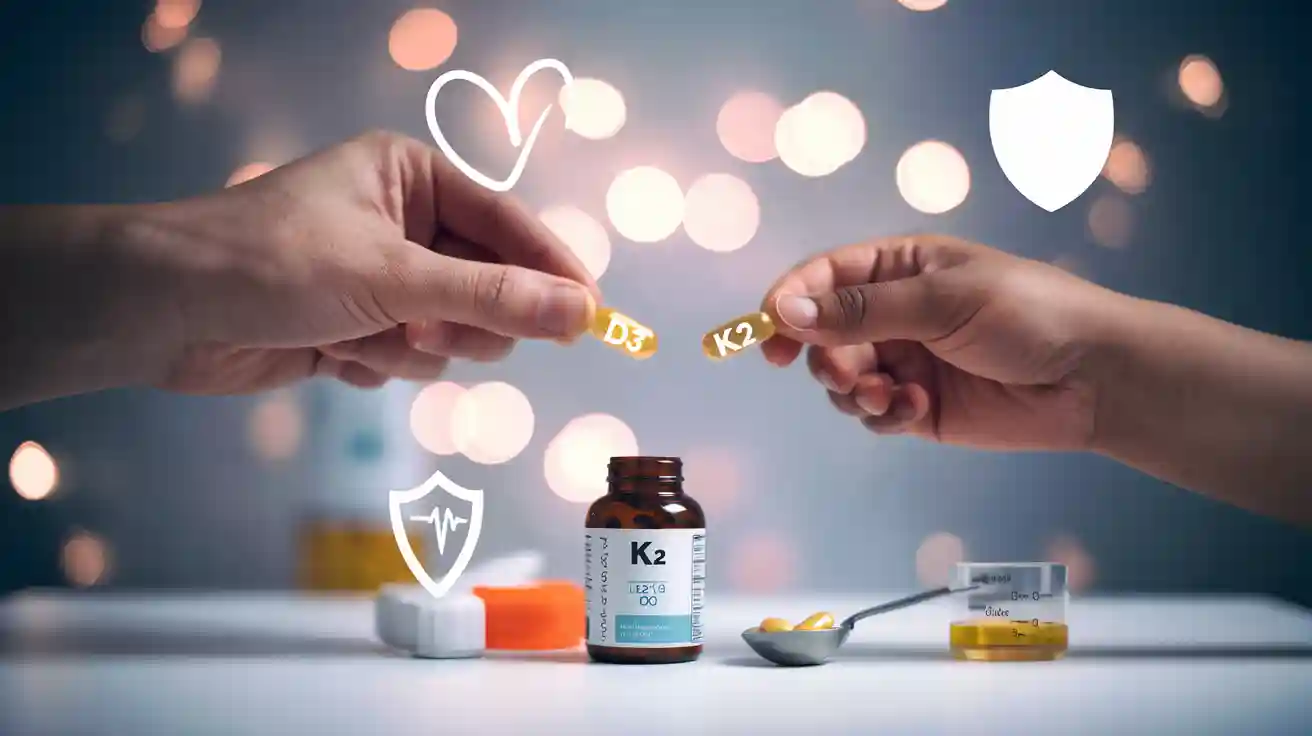
You need the right dosage of vitamin D3 and K2 for good health. Experts recommend 400 IU of vitamin D3 daily for infants, and 600 IU for most children and teens. Adults should aim for 600–800 IU of vitamin D3 each day. For vitamin K2, adults need 90–120 micrograms daily. See the table below for details from trusted organizations.
| Age Group / Population | Organization / Source | Recommended Vitamin D3 Dosage |
|---|---|---|
| Infants (birth to 1 year) | American Academy of Pediatrics | 400 IU/day |
| 1-18 years | Endocrine Society | 600–1000 IU/day |
| Adults | NIH | 600–800 IU/day |
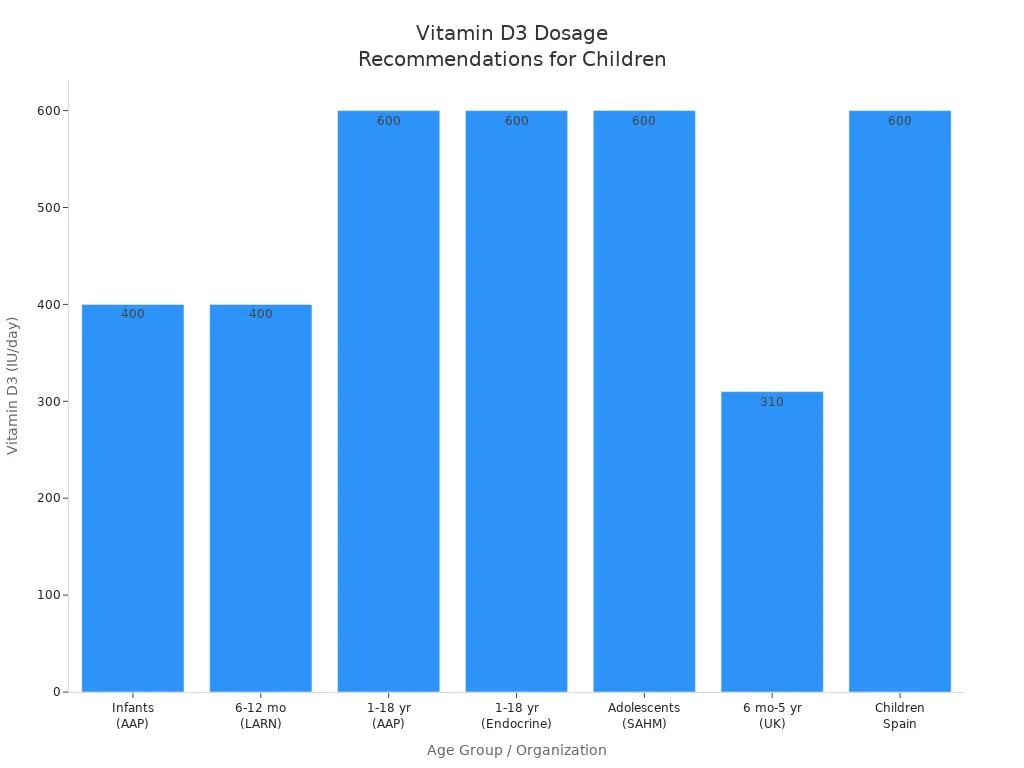
Combining vitamin D3 and K2 gives a synergistic effect that supports bone and heart health. Many people lack enough of these vitamins, so a supplement often helps. Always check with your doctor for safe dosing.
Optimal Dosage of Vitamin D3 and K2
Adults
You need to know the optimal dosage of vitamin d3 and k2 to support your health. For most healthy adults, the recommended daily intake of vitamin D3 is 600 IU if you are between 19 and 50 years old. If you are over 70, the optimal dose increases to 800 IU each day. These levels come from the NIH Office of Dietary Supplements and reflect the best available research. Some experts believe that the current vitamin d and k2 dosage guidelines may be too low for certain people. Factors like your age, skin color, sun exposure, and body weight can change your needs.
| Age Group | Recommended Daily Dosage of Vitamin D3 |
|---|---|
| Adults 19-50 | 600 IU (15 mcg) |
| Adults >70 | 800 IU (20 mcg) |
For vitamin K2, the optimal dosage depends on the form. MK7 is the most common type in supplements. You should aim for 90–120 micrograms (mcg) of MK7 daily. MK4, another form, requires much higher amounts—about 45 milligrams (45,000 mcg) each day, split into several doses. Most people choose MK7 because it stays in your body longer and works well with vitamin D3.
| Vitamin K2 Form | Optimal Dosage for Healthy Adults | Dosing Frequency | Notes |
|---|---|---|---|
| MK7 | 90-120 mcg daily | Once daily | Longer half-life, better bioavailability |
| MK4 | 45 mg (45,000 mcg) daily | 3 times daily | Short half-life, needs divided dosing |
Tip: Many combined supplements use 200 mcg MK7 and 10 mg MK4. No official RDA exists for vitamin K2, but these amounts are safe and effective for most adults.
You may need a higher vitamin d and k2 dosage if you have risk factors like obesity or limited sun exposure. Some studies show that daily intakes up to 4,000 IU of vitamin D3 are safe for adults. You should not take more than this without medical advice. Toxicity is rare but can happen with very high doses over time.
Children
Children need the right vitamin d3 and k2 intake for strong bones and healthy growth. The American Academy of Pediatrics recommends a daily vitamin D3 dosage of 400 IU for infants. For children and teens, the optimal dosage rises to 600 IU each day. Children who drink less than 1 liter of fortified milk daily should take a supplement.
| Age Group | Recommended Daily Dosage of Vitamin D3 (IU) | Maximum Safe Intake (IU) |
|---|---|---|
| Infants (breastfed or <1 L formula/day) | 400 | 1,000 |
| Children and Adolescents (<9 years) | 400 (minimum), up to 600 | Not specified |
| Children 9 years and older | Up to 600 | 4,000 |
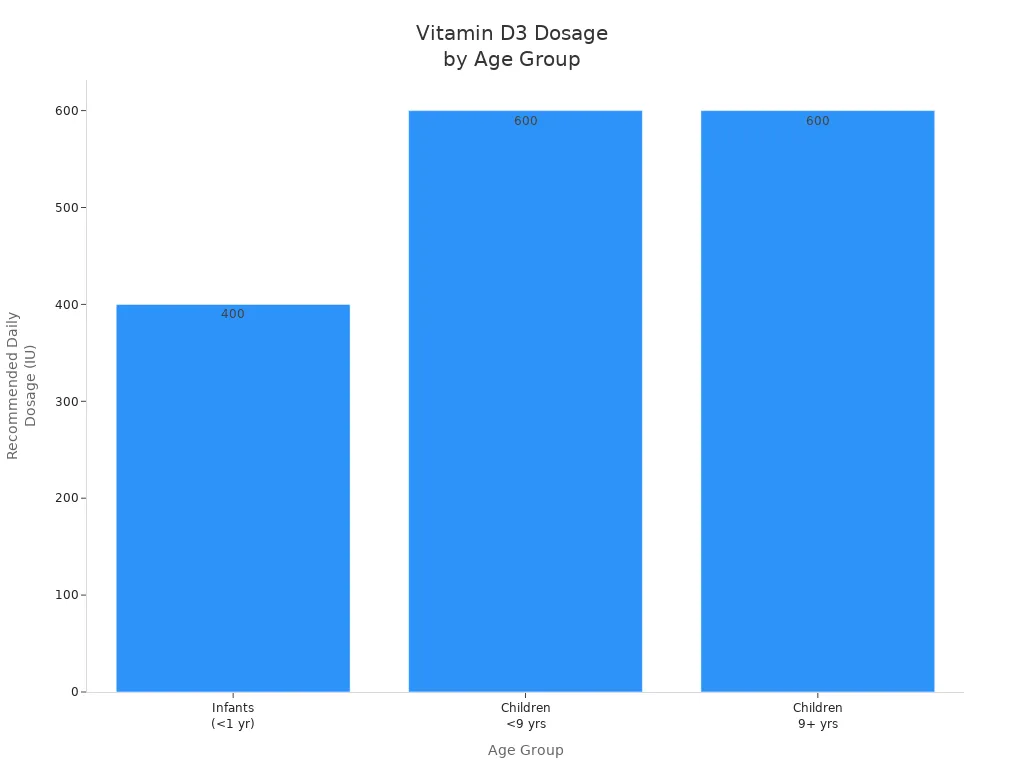
For vitamin K2, there is no official RDA for children. Experts suggest using the adequate intake for total vitamin K as a guide. For example, children aged 1–3 years need about 30 mcg daily, while those 4–6 years need 40 mcg. For children 6–10 years old, studies show that 45–50 mcg of MK7 daily supports bone health and is safe. Always talk to your child’s doctor before starting supplements, especially if your child has health conditions.
| Age Group (years) | Adequate Intake (AI) of Vitamin K (µg/day) |
|---|---|
| 0–0.5 (0–6 months) | 2 |
| 0.5–1 (7–12 months) | 10 |
| 1–3 | 30 |
| 4–6 | 40 |
| 7–10 | 50 |
| 11–13 | 70 |
| 14–17 | 75 |
Note: Vitamin D3 drops are best for infants. For older children, chewable or liquid forms work well. The best ratio of vitamin d3 to k2 for children is not set, but using both together helps bones and heart.
Special Populations
Some groups need different vitamin d and k2 dosage levels for optimal health. Pregnant women, elderly adults, and people with chronic illnesses often need more careful dosing.
- Pregnant women usually need 600 IU of vitamin D3 daily, but some experts recommend up to 2,000 IU, especially if you have low levels. The Institute of Medicine sets the upper safe limit at 4,000 IU per day.
- If you have a chronic illness like kidney disease, obesity, or malabsorption, your doctor may suggest higher vitamin d3 and k2 intake. Some people need up to 10,000 IU of vitamin D3 daily for a short time, but only under medical supervision.
- Elderly adults often need 800 IU of vitamin D3 each day to keep bones strong and prevent falls.
- For vitamin K2, there is no set dosage for special populations, but higher doses have been used safely in research for heart and bone health. The best ratio of vitamin d3 to k2 may change if you have certain health risks.
Always check your vitamin d and k2 dosage with your healthcare provider if you are pregnant, elderly, or have a chronic condition. Testing your blood levels helps find the optimal dosage for your needs.
The best ratio of vitamin d3 to k2 is still under study. Most experts agree that taking both together gives you the best results for bone and heart health. You should aim for the optimal dose based on your age, health, and risk factors. The best ratio of vitamin d3 to k2 for adults is often 1000–2000 IU of vitamin D3 with 90–200 mcg of MK7 daily. For children, the best ratio of vitamin d3 to k2 is lower, matching their smaller needs.
Remember: The best ratio of vitamin d3 to k2 supports your health at every age. Regular testing and talking with your doctor help you keep your levels in the optimal range.
Benefits of Vitamin D3 with K2
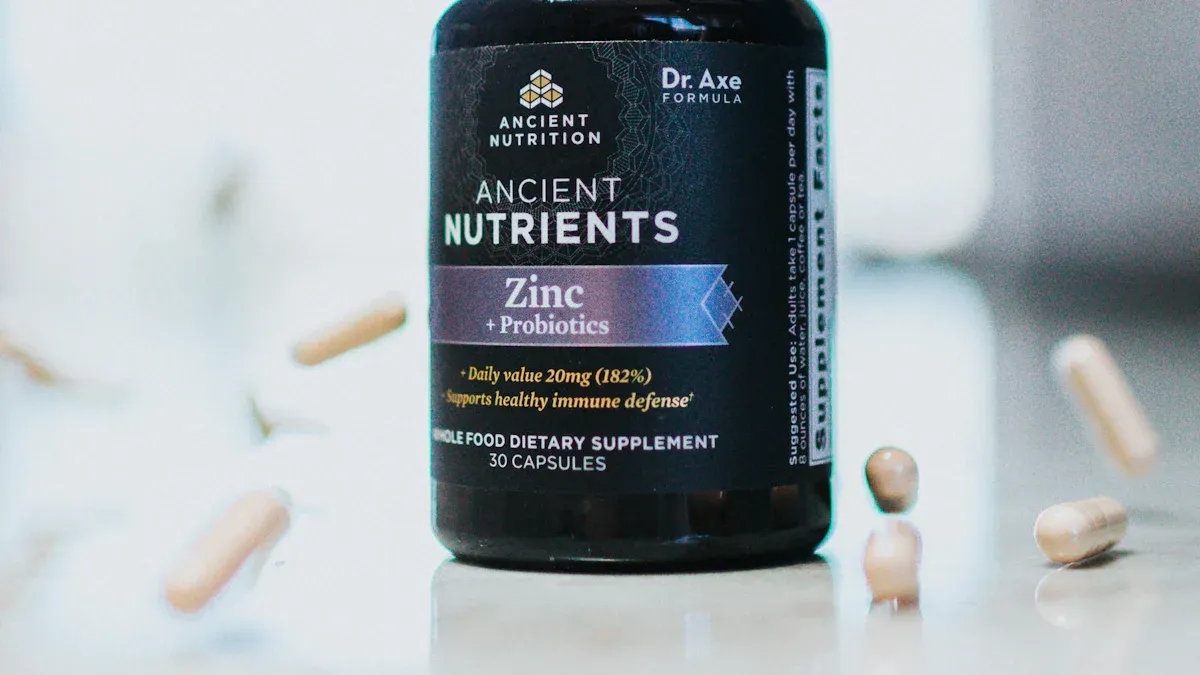
Vitamin d3 with k2 offers important effects for your body. When you use the vitamin d3 and k2 combination, you help your bones and your heart. These vitamins work together in a synergistic effect, which means they boost each other’s actions for optimal health. You get more than just vitamin d benefits or vitamin k benefits alone. This combination supports healthy calcium balance, bone health, and heart health. It also helps support immune system function and may provide anti-inflammatory effects.
Bone Health
You need strong bones for an active life. Vitamin d3 with k2 helps you reach optimal bone health by making sure your body uses calcium the right way. Vitamin D3 increases calcium absorption from your food. Without enough vitamin D3, your body cannot absorb enough calcium, and your bones may become weak. Vitamin K2 makes sure that calcium goes into your bones and teeth, not into your arteries or soft tissues. This healthy calcium balance is key for strong bones.
Vitamin K2 activates special proteins like osteocalcin and matrix Gla protein (MGP). These proteins help your bones use calcium to build a strong structure. Vitamin K2 also improves bone quality by making the bone matrix more elastic and strong. It does this by helping collagen crosslinking, which gives your bones flexibility and strength.
Clinical studies show that the vitamin d3 and k2 combination gives better results than taking either vitamin alone. In adults, especially postmenopausal women, this combination leads to higher bone mineral density and fewer fractures. The table below shows results from several studies:
| Study Location | Population | Duration | Main Effects of Vitamin D3 with K2 Combination |
|---|---|---|---|
| Japan | Postmenopausal women | 1-3 years | Increased bone mineral density, fewer fractures |
| Netherlands | Older adults | 8 weeks-2 years | Reduced bone loss, improved bone strength |
| UK | Adults | 1 year | Better bone mineral density than vitamin D or K alone |
Note: These studies did not include children, but experts believe the effects may help children’s bone health too.
Vitamin d3 with k2 helps you reach optimal health by keeping your bones strong and reducing fracture risk. You get the best effects when you use both vitamins together.
Cardiovascular Health
Your heart and blood vessels need protection from calcium buildup. Vitamin d3 with k2 helps keep your arteries flexible and healthy. Vitamin D3 helps your body make more matrix Gla protein (MGP), which is important for controlling calcium in your blood vessels. Vitamin K2 activates MGP, so it can stop calcium from building up in your arteries. This teamwork supports optimal heart health and keeps your blood flowing well.
Research shows that the vitamin d3 and k2 combination may slow down the hardening of arteries, especially in people with high risk. The AVADEC trial studied older men and found that those who took vitamin D3 and K2 had slower growth of calcium in their arteries and fewer heart problems. The table below shows some of the main effects:
| Outcome Measure | Vitamin D3 with K2 Group | Placebo Group | Statistical Significance |
|---|---|---|---|
| Mean CAC score increase (all subjects) | +203 AU | +254 AU | P = 0.089 (not significant) |
| CAC progression (subgroup with CAC ≥400 AU) | +288 AU | +380 AU | P = 0.047 (significant) |
| Adverse cardiovascular events (MI, revascularization, death) | 1.9% | 6.7% | P = 0.048 (significant) |
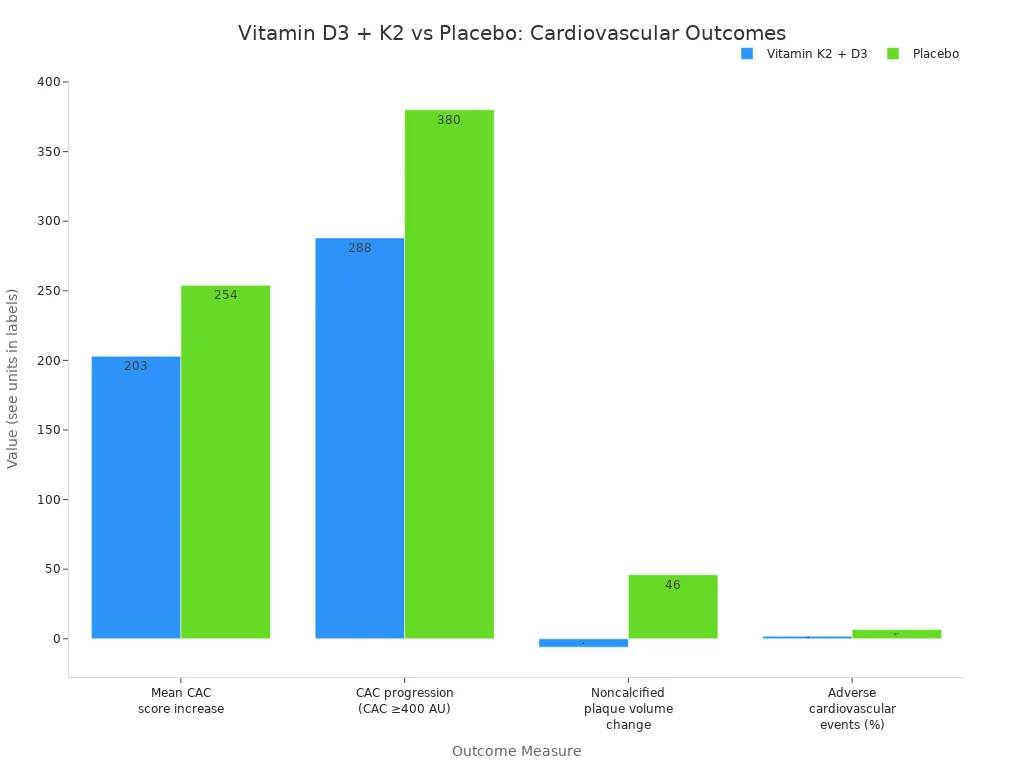
Vitamin d3 and k2 also help reduce arterial stiffness and may lower the risk of heart attacks and other serious problems. The effects are strongest in people who already have high calcium in their arteries. By using the vitamin d3 and k2 combination, you help keep your heart and blood vessels in good shape.
Tip: For optimal health, use vitamin d3 with k2 to support both bone health and heart health. This combination helps your body use calcium the right way and protects your bones and arteries.
Safe Supplementation Practices
How to Take
You want to get the most from your vitamin D3 and K2 supplement. Take your dose in the morning or early afternoon. This matches your body’s natural rhythm and sunlight exposure, which helps your energy and mood. Always take these vitamins with a meal that contains healthy fats, such as eggs, avocado, or nuts. Fat helps your body absorb these nutrients better. You can choose capsules, tablets, or drops. Drops and liquids work well if you have trouble swallowing or need flexible dosing. Look for high-quality products with third-party testing to make sure you get pure ingredients.
| Aspect | Best Practice |
|---|---|
| Timing | Morning or early afternoon |
| Meal Context | With healthy fats (eggs, avocado, nuts) |
| Supplement Form | Capsules/tablets for convenience; drops/liquids for better absorption |
| Quality | Third-party tested, minimal fillers |
Tip: Keep a routine for your daily supplement to help you remember and maintain steady levels.
Absorption Tips
You can boost absorption by following simple steps. Take vitamin D3 and K2 with meals that have healthy fats. Your body absorbs these fat-soluble vitamins much better this way. Choose supplements made from algae for D3 and MK-7 for K2. These forms work well for most people, including those who follow vegan diets. Liposomal supplements may help if you have absorption problems. Try to take your dose at the same time each day to keep your levels steady.
- Take with meals containing healthy fats.
- Use algae-based D3 and MK-7 K2 for better bioavailability.
- Liposomal forms can help if you have digestive issues.
- Avoid taking with medications that interact, such as blood thinners.
Safety and Monitoring
You need to watch your levels to stay safe. The safe upper limit for vitamin D3 is 4,000 IU daily for healthy adults. Toxicity usually happens only with very high-dose vitamin d3 supplements. Signs of toxicity include nausea, vomiting, constipation, muscle weakness, confusion, and kidney problems. High-dose vitamin d3 can also lower K2 activity, which affects bone health. No upper limit exists for K2, but you should not take more than recommended unless your doctor advises. Test your blood levels regularly if you use supplements, especially if you take high doses.
| Aspect | Details |
|---|---|
| Upper Intake Limit D3 | 4,000 IU daily |
| Toxicity Symptoms | Nausea, vomiting, constipation, muscle weakness, confusion, kidney issues |
| Toxicity Cause | Excessive supplementation, dosing errors |
| K2 Upper Limit | Not established |
| Monitoring | Regular blood tests for vitamin D levels |
Note: Always talk to your healthcare provider before starting a new supplement or changing your daily dose.
Food Sources and Supplements

Vitamin D3 Foods
You can get vitamin D3 from both animal and plant foods. Fatty fish are the richest natural sources. Wild rainbow trout, salmon, sardines, and mackerel give you a large part of your daily needs in just one serving. UV-exposed mushrooms also provide a plant-based option for vitamin D3. Egg yolks and fortified foods like milk and cereal add smaller amounts to your diet.
| Food Source | Typical Serving Size | Vitamin D Content (IU) | % Daily Value (DV) |
|---|---|---|---|
| Wild Rainbow Trout | 3 oz (steamed) | ~480 | 60% |
| Wild Coho Salmon | 3 oz (cooked) | 383 | 48% |
| Atlantic Sardines | 3.75 oz (canned) | 178 | 22% |
| UV-exposed Mushrooms | ~10 mushrooms | ~400 | Up to 100% |
| Egg Yolk | 1 large | 41 | 5% |
| Fortified Milk | 8 oz | 100–120 | 12.5–15% |
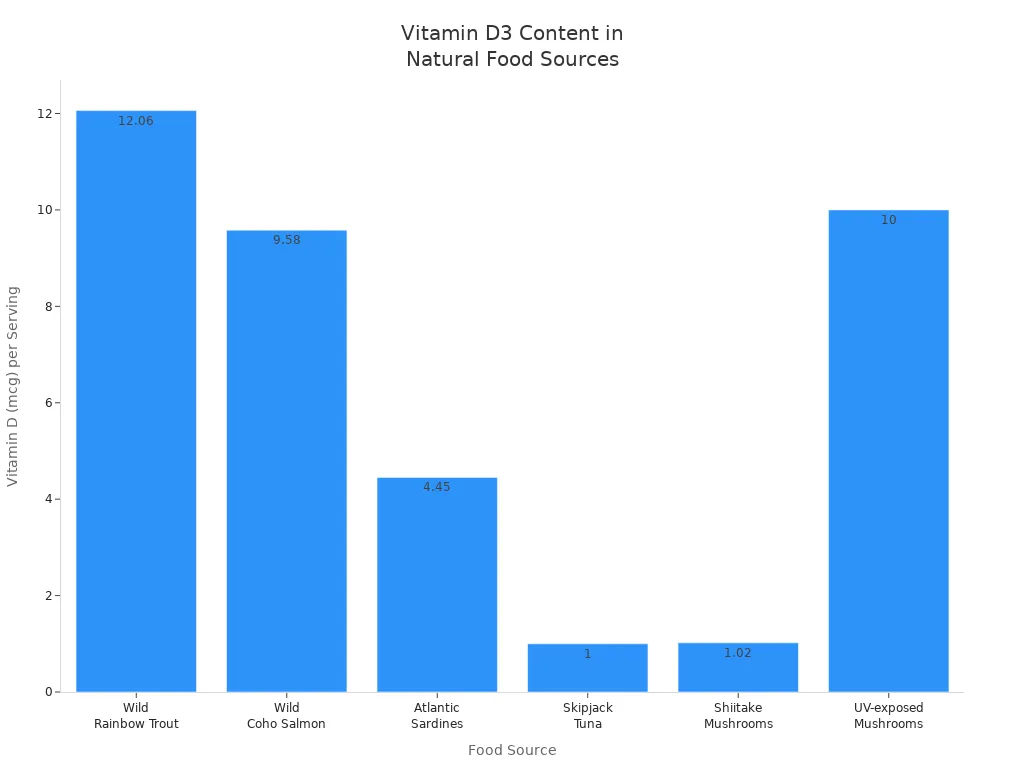
You may need to watch your intake if you do not eat fish or get much sun. Fortified foods and supplements can help fill the gap.
Vitamin K2 Foods
Vitamin K2 comes in several forms, with MK-7 and MK-4 being the most important for your health. Natto, a fermented soybean food, gives you the highest amount of MK-7. Cheeses like Munster, Camembert, and Gouda also provide good levels. Animal foods such as beef liver and chicken contain MK-4, but in smaller amounts. Fermented foods like sauerkraut and butter add a little K2 to your diet.
| Food Source | Vitamin K2 Content (mcg) | Serving Size |
|---|---|---|
| Natto | ~150 | 1 tablespoon |
| Eel | 63 | 100 grams |
| Munster Cheese | 50 | 50 grams |
| Beef Liver | >11 | 100 grams |
| Chicken | 10 | 100 grams |
| Sauerkraut | 2.75 | 1/2 cup |
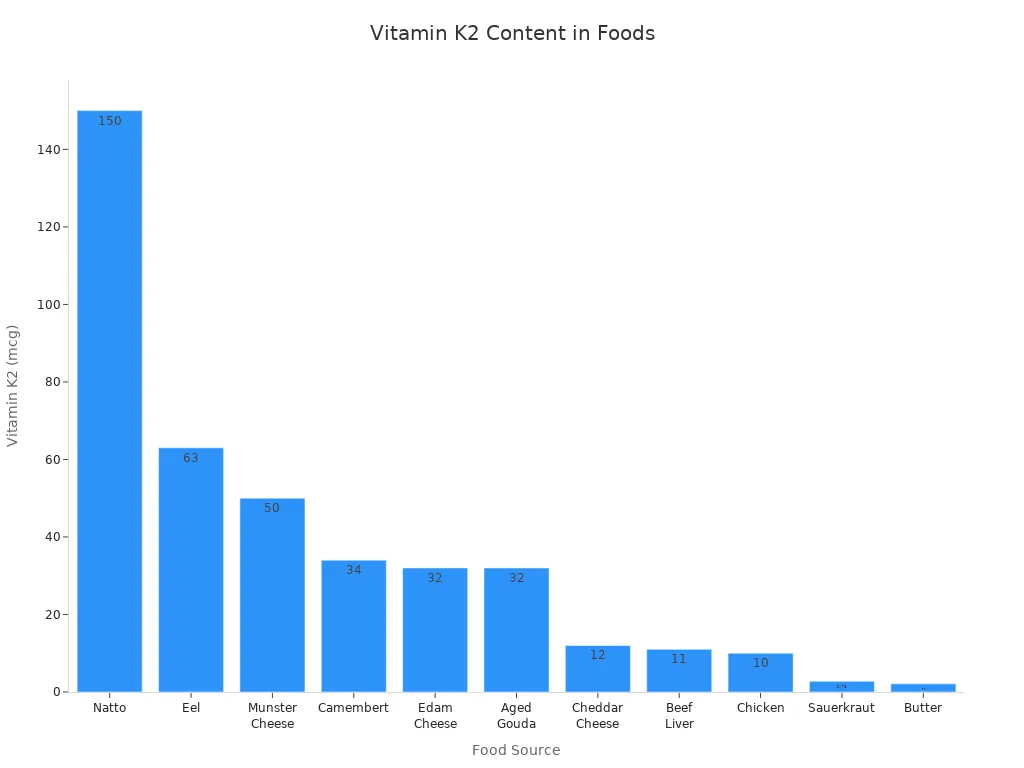
You can boost your intake by adding more fermented foods and certain cheeses to your meals.
Choosing Supplements
When you pick a vitamin D3 and K2 supplement, look for quality and safety. Choose products with third-party testing, such as USP or NSF, to make sure you get what the label promises. Avoid supplements with ingredients from sources with low safety standards. Oil-based capsules or drops work best for absorption. For children, drops or chewables make dosing easier. If you follow a vegan diet, select plant-based D3 and MK-7. Always check the label for a balanced ratio that matches your age and health needs.
Tip: Take your supplement with a meal that has healthy fats to help your body absorb both vitamins.
Consulting Healthcare Providers
When to Seek Advice
You should always talk to a healthcare provider before starting vitamin D3 and K2 supplements. Some situations make this step especially important:
- You take medications, such as blood thinners or antibiotics, which can interact with these vitamins.
- You have health conditions like kidney disease, liver problems, or any chronic illness.
- You are pregnant or breastfeeding.
- You plan to have surgery soon.
- You have allergies or have reacted badly to supplements in the past.
- You notice symptoms like nausea, vomiting, loss of appetite, constipation, weakness, weight loss, or confusion. These may signal vitamin D toxicity.
- Your child needs supplements. Children should only use vitamin D3 and K2 under medical supervision.
Tip: If you ever feel unwell after starting a supplement, stop taking it and contact your doctor right away.
Taking supplements without advice can cause problems. High doses of vitamin D3 may raise your blood calcium levels. This can lead to kidney stones, heart rhythm issues, or soft tissue calcification. Vitamin K2 can also interact with certain drugs. You need a doctor’s help to avoid these risks.
Individual Needs
Your vitamin D3 and K2 needs depend on many factors. Age, weight, and health conditions all play a role. For example, post-menopausal women often need more support for bone health. People with type 2 diabetes or high blood pressure may benefit from careful dosing. Your body weight and baseline vitamin D levels also affect how much you need.
Lifestyle choices matter, too. Smoking or drinking alcohol can change how your body uses these vitamins. Doctors may check your blood levels or other health markers to find the right dose for you.
| Factor | Why It Matters |
|---|---|
| Age | Older adults may need higher doses |
| Weight/BMI | Body size affects vitamin metabolism |
| Health Conditions | Some illnesses change your requirements |
| Medications | Some drugs interact with supplements |
| Lifestyle | Smoking and alcohol impact absorption |
Regular check-ups help you stay safe and get the most benefit from your supplements. Your doctor can adjust your dose as your needs change.
You can support your health by choosing the right vitamin d and k2 dosage. Adults often need 600–800 IU of vitamin D3 and 90–120 mcg of K2 daily, while children require age-appropriate amounts. Combining these vitamins helps your body use calcium for strong bones and a healthy heart. Regular blood tests and doctor visits help you find your best dosage.
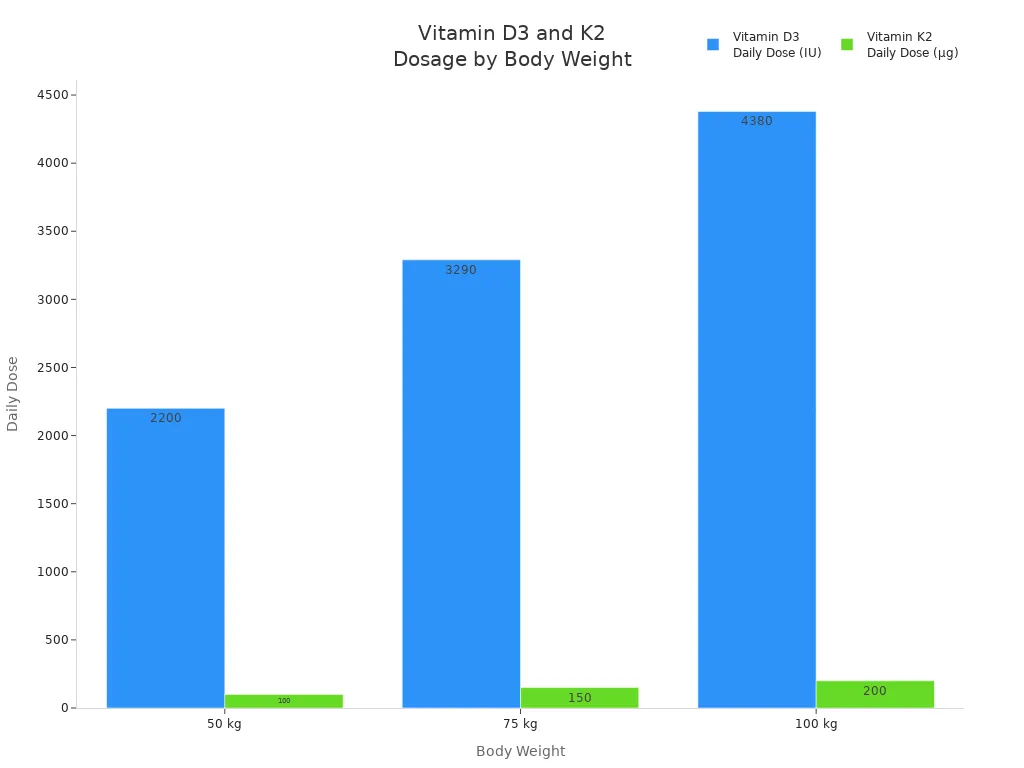

Stay proactive—monitor your vitamin levels and talk with your healthcare provider to keep your health on track.
FAQ
How do you know if you need a vitamin D3 and K2 supplement?
You may need a supplement if you get little sun, eat few vitamin-rich foods, or have low blood levels. Your doctor can check your vitamin D and K status with a simple blood test.
Can you take vitamin D3 and K2 together in one supplement?
Yes, you can take both in one supplement. Many products combine them for better results. This helps your body use calcium well and supports bone and heart health.
What happens if you take too much vitamin D3 or K2?
Too much vitamin D3 can cause nausea, weakness, or kidney problems. High vitamin K2 intake is usually safe, but you should not exceed recommended doses. Always follow your doctor’s advice.
Are there any foods that give you both vitamin D3 and K2?
Few foods contain both. Fatty fish and egg yolks give you vitamin D3. Natto and some cheeses provide vitamin K2. You may need to eat a variety of foods or use a supplement.
How long does it take to see benefits from vitamin D3 and K2?
You may notice benefits in a few weeks. Stronger bones and better energy can take longer. Regular use and healthy habits help you get the best results.

Poseidon
Master of Nutritional Epidemiology, University of Copenhagen, Herbal Functional Nutrition Researcher
Focus: The scientific application of natural active ingredients such as Tongo Ali, Horny Goat Weed, and Maca to sexual health and metabolic regulation.
Core Focus:
Men: Use a combination of Tongo Ali (an energizing factor) + Maca (an energy reserve) to improve low energy and fluctuating libido.
Women: Use a combination of Horny Goat Weed (a gentle regulator) + Maca (a nutritional synergist) to alleviate low libido and hormonal imbalances.
Stressed/Middle-Aged Adults: This triple-ingredient synergy supports metabolism, physical strength, and intimacy.
Product Concept:
Based on traditional applications and modern research (e.g., Tongo Ali promotes testosterone-enhancing enzyme activity, and icariin provides gentle regulation), we preserve core active ingredients and eschew conceptual packaging—using natural ingredients to address specific needs.
Simply put: I'm a nutritionist who understands "herbal actives." I use scientifically proven ingredients like Tongo Ali, Epimedium, and Maca to help you make "sexual health" and "nutritional support" a daily routine.
